

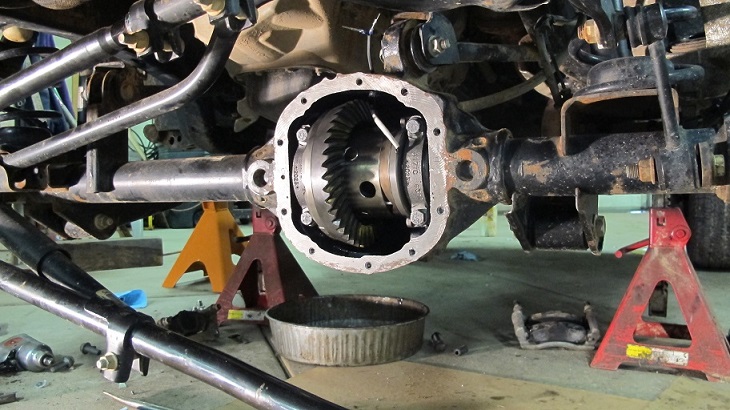
When I bough my Jeep I knew it wouldn't be long before I started to modify it. One of the most important things I wanted to do was to make it capable of running some 35" tires. The first part is to put in the lift kit. But the second part was to install gears in the axle to compensate for the tire size change. When I bought the Jeep it came with the factory installed 3.21 gears. These gears are fine for the stock 225/75R16 tires. My Jeep came with the larger 255/75R17 tires an the 3.21 gears just aren't adequate. I knew I was going to be making changes so I didn't spend the extra money on the 3.73 gear option.
After some careful deliberation, I settled on 4.56 gears to go with some 315/70R17 Goodyear Wrangler Duratrac tires. I had considered using 4.10 gears because that would put my RPMs about where they are with 3.73 gears and my factory tires. However, the larger 35" tall tires are heavier and harder to turn so the 4.56 gears will give me a little better power at the cost of running 10% higher RPMs on the road.
I decided to do some more upgrades to the Jeep while I was changing gears. Most of the changes would have required repeating the gear installation labor so it makes sense to do it while the gears are out. The rest of the changes were easier with the axles out while I was doing the rest of the work. I had to save up for a while to afford the parts but it's entirely worth it.
When changing gears from 3.21 to anything else in the JK front Dana 30, you have to replace the carrier. The cheap option is to replace it with an open differential carrier. More expensive options are lockers of various kinds. You can read up on the different types of traction aiding devices here. The rear Dana 44 in the JK uses the same carrier for all of the gear sets. But, like I always say, when you're installing gears, you might as well upgrade to a locker while you're at it instead of doing it later and paying for the labor twice.
For the front, I chose an Eaton E-Locker. It operates as an open differential until you supply 12V power to it. When you do that, an electromagnet engages the locking mechanism. This lets you drive the Jeep with the differential completely open until you need the locker. With the relatively weak front axle, the reduced stress will help ensure the axle survives as long as it can with the 35" tall tires. With the flip of a switch on the dash, the differential locks and you get all of the power going to the wheel with the traction.
For the rear, I chose an Auburn Gear ECTED. The ECTED is a clutch type limited slip differential that also can be locked. The wiring to the differential is the same as the Eaton E-Locker. However, the locking mechanism is different. Most electronic lockers use a set of cogs that engage and postively lock the two axles together. The ECTED uses an electromagnet to compress the limited slip clutch packs to the point where they no longer allow slip. This system has its limits. The bigger the tire and the more power being pushed through the ECTED, the less likely it is to fully lock the differential. But the ECTED in the JK Dana 44 rear axle is rated to handle 37" tires so it should work fine for the 35" tires on my JK.
The other upgrade I decided to do was to change the axle shafts. They have to be removed to get the differentials out to change the gears anyway. It's no extra labor to upgrade them while they're out. I purchased a set of G2 chrome molly axle shafts for the front and rear. I should take a minute to point out that at first, I attempted to upgrade the rear and go with larger diameter shafts. However, it turns out that those shafts only work in the Rubicon housing. The Sport and Sahara have a slightly different rear Dana 44 than the Rubicon. The shafts are just a little smaller and the carrier bearings are different between the two housings. So I had to return the 35 spline shafts I wanted and go with 30 spline shafts. They're still stronger than stock. They may be stronger than factory 32 spline Rubicon shafts. And for 35" tires, they should be more than strong enough for me.
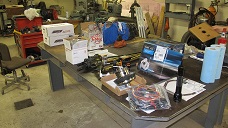 Once I found someone with the right tools and shop space to do the gear install, I ordered the parts I
needed to install them. There are several specialist tools required to do gear installation, and
working with someone who has experience makes a lot of difference. While I'm an accomplished
shade-tree mechanic, I don't have the expertise or specialty tools I needed. Fortunately, a friend in
my local Jeep club does have the experience and the tools needed to get the job done.
Once I found someone with the right tools and shop space to do the gear install, I ordered the parts I
needed to install them. There are several specialist tools required to do gear installation, and
working with someone who has experience makes a lot of difference. While I'm an accomplished
shade-tree mechanic, I don't have the expertise or specialty tools I needed. Fortunately, a friend in
my local Jeep club does have the experience and the tools needed to get the job done.
We started with the rear axle only to find out that it was not going to work. There isn't a lot of information out there that obviously states that the Rubicon uses different size bearings than the other Wrangler models and that differentials made for the Rubicon won't fit in a non-Rubicon housing. Since we were doing the work on a weekend and couldn't reach anyone for tech support, we had no choice but to button up the rear axle and leave the gears alone. At that point, I made an executive decision to proceed with the front gear installation and come back to the rear axle once the right parts arrived. I knew that I was not going to engage my 4WD while the gears were mismatched and that it would be fine for the two weeks it took to get everything straightened out.
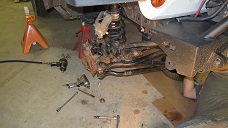
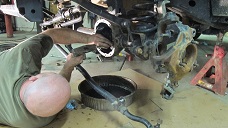 We started by tearing down the front axle. You start by draining the gear lube in the differential.
The JK axle comes with a drain plug in the bottom, on the driver's side. After the fluid is out, you
continue by removing the tires, followed by the brakes, then the unit bearings. They use some bolts
with 12 point heads, so have the right type of wrench or socket. After removing the nut at the end of
the axle shaft, the unit bearing can be taken out. It does require a bit of effort. Especially if
it's been in there for a long time. Fortunately, I had just under 8,000 miles on my Jeep so they
weren't so hard to remove. After the unit bearings are removed, the axle shafts can be removed.
After taking out the axle shafts, you need to remove the drivers side of the tie rod to give you
better access to the differential After that, remove the cover, then the differential itself can be
removed. It's important to mark the bearing caps to ensure they can be replaced exactly the way they
came out. It's also very important to keep track of the shims that come out on either side of the
differential. They may look the same but they can be different in thickness by tens of thousands of
inches. Finally, the pinion can be removed. It takes several hundred foot pounds of torque to remove
the nut. If you don't have a bigger than industrial strength impact gun you need a really big breaker
bar with at least a 3/4" or 1" drive to handle the 5 foot long extension you need to put on the
breaker bar. You can use the flange bolts with a pry bar wedged between them and the ground to keep
the pinion from rotating. After the pinion nut is removed you can drive out the pinion with a punch
and a hammer, followed up by driving out the bearing races.
We started by tearing down the front axle. You start by draining the gear lube in the differential.
The JK axle comes with a drain plug in the bottom, on the driver's side. After the fluid is out, you
continue by removing the tires, followed by the brakes, then the unit bearings. They use some bolts
with 12 point heads, so have the right type of wrench or socket. After removing the nut at the end of
the axle shaft, the unit bearing can be taken out. It does require a bit of effort. Especially if
it's been in there for a long time. Fortunately, I had just under 8,000 miles on my Jeep so they
weren't so hard to remove. After the unit bearings are removed, the axle shafts can be removed.
After taking out the axle shafts, you need to remove the drivers side of the tie rod to give you
better access to the differential After that, remove the cover, then the differential itself can be
removed. It's important to mark the bearing caps to ensure they can be replaced exactly the way they
came out. It's also very important to keep track of the shims that come out on either side of the
differential. They may look the same but they can be different in thickness by tens of thousands of
inches. Finally, the pinion can be removed. It takes several hundred foot pounds of torque to remove
the nut. If you don't have a bigger than industrial strength impact gun you need a really big breaker
bar with at least a 3/4" or 1" drive to handle the 5 foot long extension you need to put on the
breaker bar. You can use the flange bolts with a pry bar wedged between them and the ground to keep
the pinion from rotating. After the pinion nut is removed you can drive out the pinion with a punch
and a hammer, followed up by driving out the bearing races.
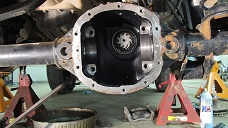
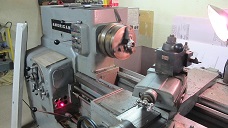 Once the axle is disassembled, you can start the gear install. On the JK, you need to put a shim
between the head of the pinion and the bearing to get the pinion in exactly the right place so it
meshes with the ring gear correctly. We reused the factory shim as a staring point. We used a press
to push the inner bearing on. After that, we took the old outer bearing and put it on the lathe to
grind out the inner diameter a few thousandths. This allows you to slide it on and off while you do
the work to adjust the shims. Had we been thinking, we would have done the same with the inner
bearing but it turned out that we didn't need to. Once we had our outer setup bearing we assembled
the pinion into the housing and started with the differential itself.
Once the axle is disassembled, you can start the gear install. On the JK, you need to put a shim
between the head of the pinion and the bearing to get the pinion in exactly the right place so it
meshes with the ring gear correctly. We reused the factory shim as a staring point. We used a press
to push the inner bearing on. After that, we took the old outer bearing and put it on the lathe to
grind out the inner diameter a few thousandths. This allows you to slide it on and off while you do
the work to adjust the shims. Had we been thinking, we would have done the same with the inner
bearing but it turned out that we didn't need to. Once we had our outer setup bearing we assembled
the pinion into the housing and started with the differential itself.
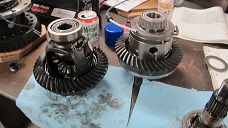 Fortunately, the Dana 30 uses shims on the outside of the carrier bearings. This means you don't have
to remove the bearings if you need to replace the shims. We started with the same shims the factory
used in the same location. This usually gets you close to where you need to be. We installed the new
differential into the housing and painted on the gear marking compound. After having some bad luck
early in the day we managed to find some good luck. The factory shims worked exactly perfectly with
the new gears. We used a dial indicator to check the backlash and it was right at 8 thousandths,
which is right in spec. When we turned the gears and check the pattern in the marking compound we saw
a pattern that was just about perfect. After we took out the differential and checked the pinion, it
too had marking compound exactly were it needed to be. Because of that we didn't have to adjust a
single shim.
Fortunately, the Dana 30 uses shims on the outside of the carrier bearings. This means you don't have
to remove the bearings if you need to replace the shims. We started with the same shims the factory
used in the same location. This usually gets you close to where you need to be. We installed the new
differential into the housing and painted on the gear marking compound. After having some bad luck
early in the day we managed to find some good luck. The factory shims worked exactly perfectly with
the new gears. We used a dial indicator to check the backlash and it was right at 8 thousandths,
which is right in spec. When we turned the gears and check the pattern in the marking compound we saw
a pattern that was just about perfect. After we took out the differential and checked the pinion, it
too had marking compound exactly were it needed to be. Because of that we didn't have to adjust a
single shim.
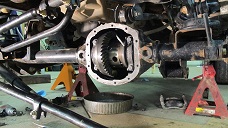 At this point it was time to start final assembly. We removed the setup bearing and put the last
parts in place. One of those parts is a crush sleeve. It is designed to keep the bearings in place
so they don't wear out prematurely. But, as its name implies, needs to be crushed in place. That
means turning a wrench with a very long handle. The impact wrench we had wouldn't even come close.
It took the same setup to install the pinion nut as it did to remove it. And after a lot of heavy
effort by my friend, who is a lot stronger than me, the sleeve was properly crushed and the right
preload was on the bearings. After that, we drilled the hole for the wiring to the locker, giving the
inside of the housing a thorough cleaning after. Then we installed the differential permanently,
routing the wires through the new hole.
At this point it was time to start final assembly. We removed the setup bearing and put the last
parts in place. One of those parts is a crush sleeve. It is designed to keep the bearings in place
so they don't wear out prematurely. But, as its name implies, needs to be crushed in place. That
means turning a wrench with a very long handle. The impact wrench we had wouldn't even come close.
It took the same setup to install the pinion nut as it did to remove it. And after a lot of heavy
effort by my friend, who is a lot stronger than me, the sleeve was properly crushed and the right
preload was on the bearings. After that, we drilled the hole for the wiring to the locker, giving the
inside of the housing a thorough cleaning after. Then we installed the differential permanently,
routing the wires through the new hole.
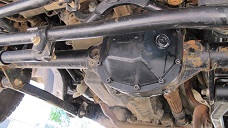 Once the internals were done, we started the reassembly. I decided to replace the differential cover
with a heavier one. Because I'm going to be driving around off road, the factory stamped sheet metal
cover doesn't hold up well to rocks so I bought a replacement cover from
Blue Torch Fab. I had it powder coated by a friend to keep
it from rusting more than anything else. When I installed it, I took the advice of an experienced off
roader and tried out a new gasket made by LubeLocker. The rest of
the reassembly is pretty easy. It's important to use anti-seize when putting the unit bearing in.
You can opt not to do it but when you're out on the trail swapping out a shaft or a u-joint and you
have to take it apart, you'll thank me for doing it. If you don't, the bolts and the bearing itself
will rust to the point where you almost can't get them apart.
Once the internals were done, we started the reassembly. I decided to replace the differential cover
with a heavier one. Because I'm going to be driving around off road, the factory stamped sheet metal
cover doesn't hold up well to rocks so I bought a replacement cover from
Blue Torch Fab. I had it powder coated by a friend to keep
it from rusting more than anything else. When I installed it, I took the advice of an experienced off
roader and tried out a new gasket made by LubeLocker. The rest of
the reassembly is pretty easy. It's important to use anti-seize when putting the unit bearing in.
You can opt not to do it but when you're out on the trail swapping out a shaft or a u-joint and you
have to take it apart, you'll thank me for doing it. If you don't, the bolts and the bearing itself
will rust to the point where you almost can't get them apart.
After the axle was done, we took the Jeep out for a few mile spin. We managed to find some more good luck and ran into no problems at all. No leaks, no funny noises, no weird behavior. It all just worked.
Two weeks later, the replacement parts for the rear axle had arrived and we scheduled a wrenching party. We installed not only the gears but the lift kit, replacement bolt kit, and the truss for the front axle as well. The rear gear install went about the same as the front so there isn't a long description of it. The only difference was that the shim packs weren't quite right and it took a couple of tries to get it dialed in.
The build started by getting the Jeep in the air off its tires. Since we were going to do a lot of work on the Jeep, I decided to go ahead and replace the bolts in the suspension with the Northridge Grade 8 hardware kit. You may ask why anyone would replace the factory suspension bolts. Well, it's because the factory installed the wrong type, and in one case, the wrong size of bolt. The factory uses fully threaded bolts. They have threads from the head to the tip. This ends up being a problem in the long run. The threads have a tendency to dig into the metal sleeve in the control arm bushing. This can lead to excessive free movement of suspension components. The replacement hardware kit uses shouldered bolts. This means they are only partially threaded. A majority of the bolt has a smooth surface that the bushings can ride in, prolonging their life. Additionally, the track bar bolt supplied by the factory is the wrong size. The bolt is 12mm in diameter but the holes in the bushing and the bracket are 1/2" in diameter, which is 12.7mm. That may not sound like much but it can cause the track bar to move excessively which causes the hole in the thin metal bracket to elongate, leading to various problems. So with the proper bolts installed, the suspension should last longer than it otherwise would.
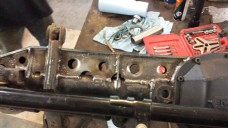
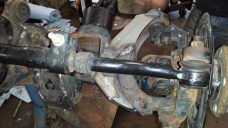 Since the axles were getting unbolted, and it's not much more work to remove them completely, we
decided to do just that. So while our resident gear swap expert was tackling the gear install for the
rear axle, I started installing the Artec Industries
Front Axle Armor Kit.
The front armor kit addresses most of the weaknesses of the JK Dana 30 axle housing. When using larger
tires, the JK front axle has a tendency to bend over time. The axle tubes and the inner C's are just
not strong enough to hold up to abuse. The armor kit comes with a truss for the axle tubes and
gussets for the inner C's. It also comes with plates to reinforce the lower control arm bracket and
to act as a skid plate.
Since the axles were getting unbolted, and it's not much more work to remove them completely, we
decided to do just that. So while our resident gear swap expert was tackling the gear install for the
rear axle, I started installing the Artec Industries
Front Axle Armor Kit.
The front armor kit addresses most of the weaknesses of the JK Dana 30 axle housing. When using larger
tires, the JK front axle has a tendency to bend over time. The axle tubes and the inner C's are just
not strong enough to hold up to abuse. The armor kit comes with a truss for the axle tubes and
gussets for the inner C's. It also comes with plates to reinforce the lower control arm bracket and
to act as a skid plate.
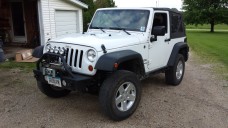 Once the truss was welded on and the gears installed, it was time to reassemble the Jeep. I took
advantage of the axles being out to install the bump stop extensions that came with the lift kit.
Then it was just putting the new springs and shocks in place while we bolted it up and put the tires
back on. I already had a Bully Dog GT
Programmer so I was able to use it to program the computer to know about the new gear ratio. Once
that was taken care of, we took it out for a quick spin. It developed an infrequent squeal that
we didn't immediately diagnose. However, it turned out that one of the brake backing plates had bent
while the axle was out and it was rubbing on the brake rotor.
Once the truss was welded on and the gears installed, it was time to reassemble the Jeep. I took
advantage of the axles being out to install the bump stop extensions that came with the lift kit.
Then it was just putting the new springs and shocks in place while we bolted it up and put the tires
back on. I already had a Bully Dog GT
Programmer so I was able to use it to program the computer to know about the new gear ratio. Once
that was taken care of, we took it out for a quick spin. It developed an infrequent squeal that
we didn't immediately diagnose. However, it turned out that one of the brake backing plates had bent
while the axle was out and it was rubbing on the brake rotor.
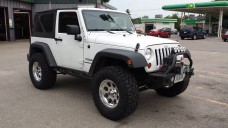
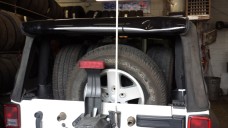 A couple of days later, the new tires arrived and I took the Jeep into the shop to get them mounted on
the rims. The shop had to transfer over the tire pressure monitoring sensors but that wasn't a big
deal. I took out the rear seat and had them throw the tires in the back. If you were curious, I can
tell you that all 5 factory 255/75R17 tires will, in fact, fit in the back of a 2 door Wrangler so long
as the rear seat has been removed. After the new tires were mounted, I used my programmer to set the
tire size to match the advertised tire diameter for the Duratrac. However, the speedometer was off a
little bit, as I expected it might be. So many things affect the speedometer, from air pressure in
the tire to weight in the vehicle. I decided to break out the GPS and get on the freeway. I did a
little simple arithmetic and figured out exactly how far off the speedometer was, and to verify that
it was consistent at various speeds. I then programmed the closest diameter I could into the computer
and took it for another spin. It is as accurate as I could possibly make it, being less than 1 MPH
off at 70.
A couple of days later, the new tires arrived and I took the Jeep into the shop to get them mounted on
the rims. The shop had to transfer over the tire pressure monitoring sensors but that wasn't a big
deal. I took out the rear seat and had them throw the tires in the back. If you were curious, I can
tell you that all 5 factory 255/75R17 tires will, in fact, fit in the back of a 2 door Wrangler so long
as the rear seat has been removed. After the new tires were mounted, I used my programmer to set the
tire size to match the advertised tire diameter for the Duratrac. However, the speedometer was off a
little bit, as I expected it might be. So many things affect the speedometer, from air pressure in
the tire to weight in the vehicle. I decided to break out the GPS and get on the freeway. I did a
little simple arithmetic and figured out exactly how far off the speedometer was, and to verify that
it was consistent at various speeds. I then programmed the closest diameter I could into the computer
and took it for another spin. It is as accurate as I could possibly make it, being less than 1 MPH
off at 70.
So after a false start and a bunch of headache, I have the Jeep about where I want it for now. The lockers are great, both on the road and off. The tires are about as good a balance between on and off road as I could ask for. They don't handle the really goopy mud very well but I didn't expect them to. They do handle the snow like a champ however. And while they hum a little at highway speeds, they're substantially better than pretty much every mud terrain tire I've ever heard. The gears are right for the tires. I used to not be able to run in 6th gear on the highway unless I was going downhill with a tail wind. But now I can hold my speed and even accelerate up mild grades without having to down shift. But the ultimate question is this: Knowing what I know now, would I do the same thing again? The answer is yes. I'd go straight to the correct non-Rubicon locker and axle shafts, of course, but overall I'm happy with not only how the Jeep looks but how it performs, both on and off road.